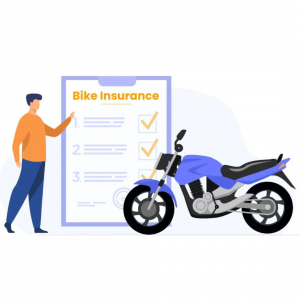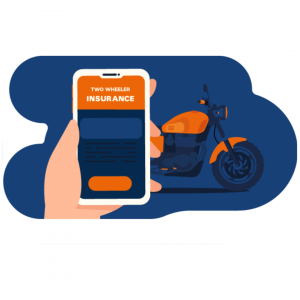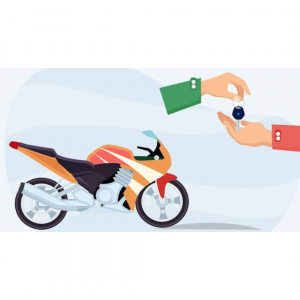Understanding Two-Wheeler Insurance
Two-wheeler insurance is an insurance plan focused on protection and coverage for bikes. It covers the cost of repairs in the case of accidental damages to your bike.
Apart from accidents, it also provides financial security from incidents like thefts, natural disasters, vandalism, etc. and third party liabilities.
Benefits of ICICI Lombard Bike Insurance
- Instant online policy
- 24×7 roadside assistance
- 6200+ all-India cashless garages
- Service guarantee on repairs done at network garage
- Service guarantee on
Types of Bike Insurance Policies
Different people have different requirements when it comes to insurance coverage for their two-wheeler. To cater to their different needs, we have three main types of two-wheeler insurances.
1) Comprehensive Policy:-
This two wheeler insurance plan protects the owner from the costs incurred in accidental damages to a third party as well as to own vehicle. You can even select add-ons by paying a nominal additional premium, to enhance your coverage under such cover. It also provides you with a personal accident cover of ₹15 lakh for accidental death and disability at a small additional premium.
Who is it suitable for?
If you already have an active third party policy for your two wheeler.
What does it cover?
-Accident
-Damage in transit
-Theft
-Third party liability
-Fire
-Personal accident
-Natural calamities
-Add-ons
2) Standalone own damage policy:-
Our stand-alone own damage two wheeler insurance plan covers the damages to your bike or scooter caused by natural disasters like earthquake, flood, cyclone, landslide, etc. or man-made disasters like theft, burglary, riot, strike, etc.
Who is it suitable for?
If you already have an active third party policy for your two wheeler.
What does it cover?
-Accident
-Natural calamities
-Theft
-Damage in transit
-Fire
-Add-ons
3) Third party cover:-
This type of insurance policy covers you against legal liabilities arising out of an accident. Under this type of two wheeler insurance policy, if your bike causes injuries to a third party or his= surrounding property, then your insurer will take care of these expenses.
Who is it suitable for?
This type of policy is not recommended for any bike owner. Even if your bike is lying idle in parking, you still run the risk of theft, fire, parking accidents and more. Consider this only if you don’t mind paying for bike repairs out-of-pocket.
What does it cover?
-Third party property damage
-Injury to the third party
Benefits of having a bike insurance
Biking and owning a bike has several benefits. For instance, a two-wheeler is far easier and less expensive to purchase and maintain than a car. Notwithstanding these benefits, riding a bike in poor road conditions and with plenty of traffic is very risky. Additionally, unruly driving by other people, inclement weather, and spills on the road can cause damage to you and your car. Not to add that in recent years, bike theft has become a major issue. Therefore, getting a dependable bike insurance policy is more essential. The following are some advantages of two-wheeler insurance:
– Financial protection
– Roadside assistance
– Coverage for spare parts
– required in repairs
– Coverage for bike theft
– Coverage for accidental injuries
How to Choosing the Right Policy?
The right choice when it comes to selecting a policy has to be made carefully. The key to doing so effectively is to know what to look for, what would be right for you, and trying to find a balance between the two. Here are a few points you should focus on to select a good two-wheeler insurance policy:
- Coverage—type of policy, IDV, add-ons
- Cashless garage network
- Claim servicing
- Claim settlement ratio
- Customer feedback
Comparing Premiums Effectively
Everybody enjoys a good deal, and insurance premiums are no different. On the surface, a bike insurance quote could seem good, but before deciding, check it more closely to make sure there are no surprises when it comes time to file a claim. Here’s how to accomplish it step-by-step:
1. Premium break-up
Ask for a premium break-up and take a closer look at the components
2. Personal damage insurance
In your split, look for own damage premium. This is the actual coverage for theft, damage, and repairs to your bike. Know that your accidental damages will not be covered by the policy if you are unable to locate it.
When determining if you qualify for OD premium, consider the following two factors:
- The insured declared value, or IDV. Should the IDV coverage be insufficient, your premium will be minimal
- NCB: The discount you receive for not filing a claim during the prior policy year is known as NCB. You must renew your insurance within ninety days of its expiration in order to qualify for this. It’s important to remember that while NCB lowers your premium, choosing the wrong NCB can result in claim denial just when you need it most. Therefore, purchase a real coverage that will support you during your time of need.
3. Third-party insurance
This coverage safeguards you in the event that an accident occurs and you injure a third party.
- Coverage for third party property damage up to ₹1 lakh.
- Unlimited coverage in the event that someone else passes away or becomes disabled. The court determines this sum.
This premium is the same for all insurance providers.
4. Personal accident premium
It is mandatory to have a personal accident cover for the owner-driver of any vehicle. This cover is for an individual. So, you only need one such cover even if you own multiple vehicles.
5. Add-on premium
Check if your requested add-ons are present in the break-up. This will ensure that you get the coverage you have asked for and you are aware of the amount you are paying for them.
Why is bike insurance necessary?
Bike insurance offers a host of coverage features that can save you a lot of money and effort. These include coverage for repairing accidental damage to your bike, personal accident cover, and much more. Secondly, having an insurance policy while driving any vehicle is necessary. Being caught riding a bike without an insurance policy can lead to a fine of ₹2000 and/or imprisonment.
How to buy two wheeler insurance online?
Even though the process of buying bike insurance online is simple, different people can have a varied set of doubts. Here’s what you need to do:
1) Visit the bike insurance page on our website.
2) Enter all the necessary details like your mobile no, email ID, bike registration number, registration year etc.
3) In the next step you can select the plan of your choice.
4) After the main selection, you can choose to edit your coverage as much as the insurance provider allows by selecting the right add-ons, deductibles etc.
5) When your selection is finished, you can make a payment through debit cards, credit cards, net-banking, etc.
6) You will then receive your policy documents through email.
Understanding NCB in bike insurance?
An abbreviation for no claim bonus, NCB is an extra benefit that is provided with a bike insurance policy. As per this benefit, each year that you go without making a claim on your policy, you will earn a bonus. This way, you end up reducing the cost of insurance with each passing year. Moreover, the percentage of bonus offered grows with back-to-back claim-free year until it reaches 50%. Hence, you can get a maximum of 50% of your premium as a no claim bonus if you don’t make a claim.
Understanding IDV in Bike Insurance?
Known as insured declared value, IDV is a fixed and maximum amount of money that the insurance provider promises a customer in case his/her bike is damaged beyond repair in an accident or in case of a theft. This value depends on the market value of the bike at the time of purchasing the policy. As a result of depreciation, the IDV usually decreases with each policy renewal.
How to calculate two wheeler insurance premium online?
Premium is one of the most important part of buying insurance. Hence, it is better to have an idea of what your coverage will cost you. However, due to the numerous factors involved, calculating premium manually is extremely difficult and tedious. Hence, you can use a two-wheeler insurance calculator to get a near-accurate quote for your coverage. Here is how you can calculate the premium:
1) Visit the bike insurance page on our website.
2) Enter all the necessary details like your mobile no, email ID, bike registration number, registration year etc.
3) Select the type of insurance policy you want to buy.
4) Submit all this data and our results will be shown to you on the screen in a matter of minutes.
Saving on Premiums
The entire goal of insurance is to save money. Then, why should that idea change while buying an insurance policy. Here are a few tricks that you can use to reduce your premium while getting the same amount of coverage. These include:
1. Claiming NCB benefit
If you are a sound driver, you will rarely find yourself in a situation of making a claim. Use it to your advantage by enjoying your NCB benefit.
2. Installing safety devices
Installing safety devices means there is a lesser chance of your vehicle being stolen. As a result of the lower risk, the insurer is likely to offer a lower premium.
3. Compare plans
The best way to find an affordable bike insurance is to compare different policies.
Renewing and Buying Bike Insurance Online
Renewals are an important part of having bike insurance. Since the policy has a tenure of one year mostly, it requires renewal every year to keep the coverage intact. If you fail to do so, your coverage lapses and you have to go through the hassle of buying a new policy again.
1) To renew the policy, log on to our website.
2) Fill the required details like your vehicle, your current coverage, etc.
3) Make a payment through debit cards, credit cards, net-banking, etc. As soon as the process is finished you will receive your policy through email.
FAQ’s
Q1 What factors affect bike insurance premiums?
A1 Premiums are influenced by various factors including the make and model of your bike, your location, your age and driving experience, the coverage options you select, and your claim history.
Q2 Is bike insurance mandatory in India?
A2 Yes, as per the Motor Vehicles Act, it’s mandatory to have at least third-party insurance coverage for your bike. Riding without insurance can lead to hefty fines and legal consequences.
Q3 What is the claim settlement process for bike insurance?
A3 In case of an accident or damage to your bike, you should inform your insurance provider immediately. The process typically involves filing a claim, providing relevant documents like the FIR (in case of theft or accident), estimate of repairs, etc. The insurer will assess the damage and settle the claim as per the terms of your policy.
Q4 Can I transfer my bike insurance policy to a new owner?
A4 Yes, bike insurance policies are transferable. If you sell your bike, you can transfer the insurance policy to the new owner. This involves notifying the insurance company about the change in ownership and completing the necessary paperwork.
Q5 What is voluntary deductible in bike insurance?
A5 Voluntary deductible is the amount you agree to pay out of your pocket towards any claim before the insurance coverage kicks in. Opting for a higher voluntary deductible can lower your premium but also increases your out-of-pocket expenses in case of a claim.
Q6 Can I cancel my bike insurance policy?
A6 Yes, you can cancel your bike insurance policy at any time by informing your insurance provider. However, you may be entitled to a refund of the premium only if you haven’t made any claims during the policy term.
Q7 Does bike insurance cover accessories installed in the bike?
A7 Standard bike insurance usually covers the cost of accessories that are included in the manufacturer’s listed selling price of the bike. However, for additional accessories, you may need to purchase add-on coverage.
Q8 What happens if I forget to renew my bike insurance policy?
A8 If you forget to renew your bike insurance policy before it expires, your coverage lapses. Riding without insurance is illegal and can leave you financially vulnerable in case of an accident or theft. It’s important to renew your policy on time or opt for auto-renewal options offered by insurance providers.











